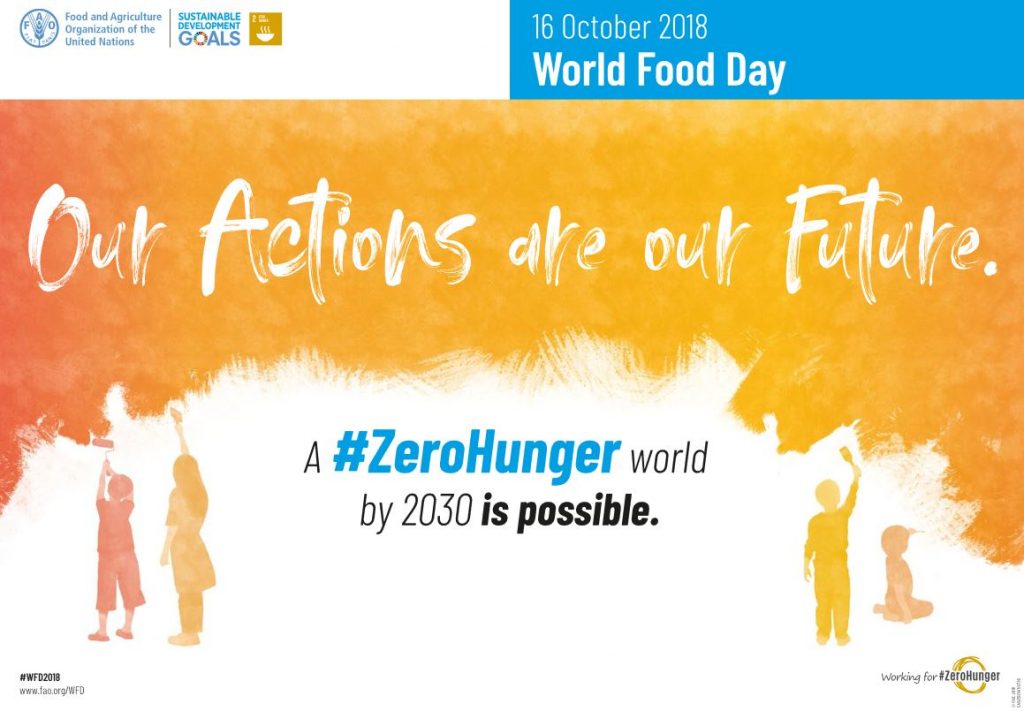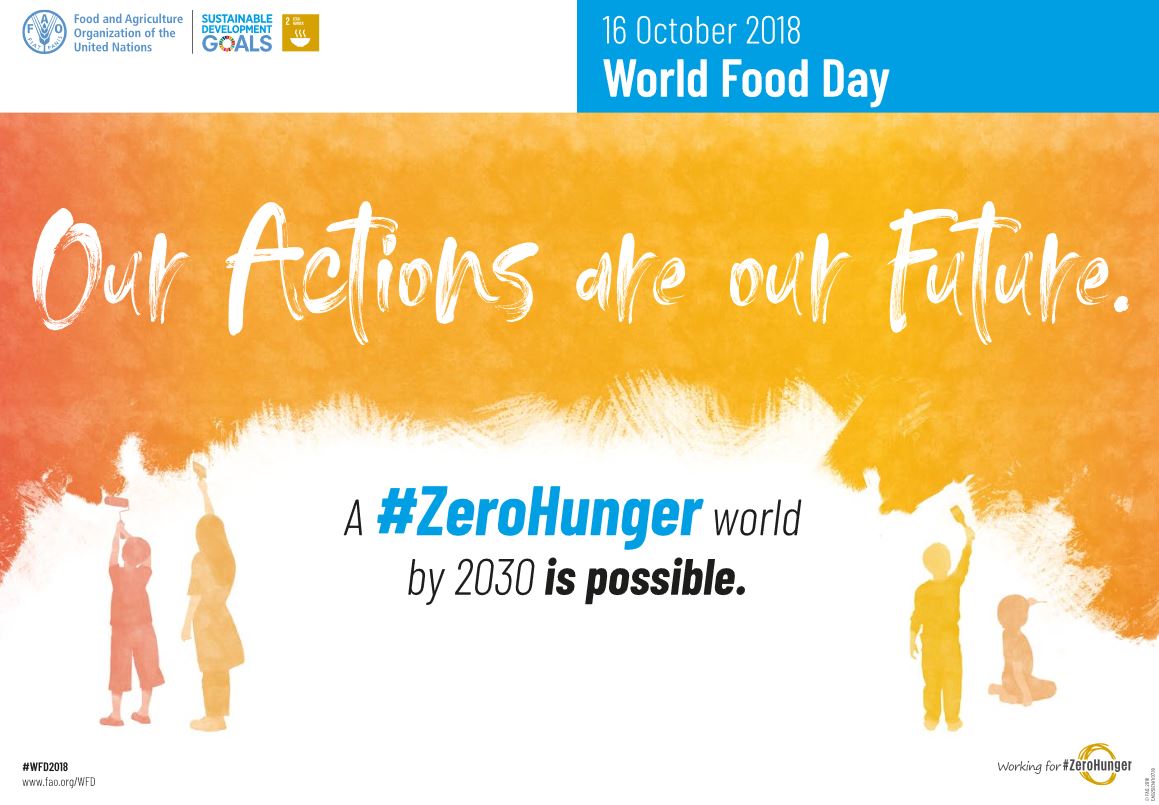Tuesday next week, the 16th October, is World Food Day. Toni Pyke sketches out the background to the international day and introduces a new #ZeroHunger series, brought to you by the Professional Development Support Service for Teachers (PDST), developmenteducation.ie, Concern Worldwide and Self Help Africa.
World Food Day (WFD) commemorates the founding of the UN agency the Food and Agriculture Organisation (FAO) which was formally established in 1945. For nearly 40 years since 1979, countries around the world have marked WFD not only as a reminder of the founding of the FAO, but more importantly, to remind the world of the relentless hunger and malnutrition that continues to plague millions of us around the globe. Marked by more than 150 countries around the world, WFD seeks to heighten awareness and action in support of those experiencing hunger, food insecurity, undernourishment and malnutrition.
The first global action of WFD was marked in 1981 with the theme: Food Come First. The theme for this year is Our Actions, Our Future (see here for a full list of themes).

According to the FAO, the objectives of marking and acting on World Food Day are to:
- encourage attention to agricultural food production and to stimulate national, bilateral, multilateral and non-governmental efforts to achieve this
- encourage economic and technical cooperation among developing countries
- encourage the participation of rural people, particularly women and the least privileged categories, in decisions and activities influencing their living conditions
- heighten public awareness of the problem of hunger in the world
- promote the transfer of technologies to the developing world
- strengthen international and national solidarity in the struggle against hunger, malnutrition and poverty and draw attention to achievements in food and agricultural development.
The wider message is that food for all is a basic, fundamental human right. Yet despite this, the WFP report that some 821 million people worldwide – that’s 1 in 9 – still go to bed on an empty stomach each night. Added to this, 1 in 3 suffer from malnutrition (the deficiencies, excesses or imbalances in a person’s intake of energy and/or nutrients – WHO). There are also while 1.9 billion people in the world who are overweight.
Being aware of, marking and publicising WFD is a chance to demonstrate that we are committed to the achieving ‘Zero Hunger by 2030’, which is the aim of Sustainable Development Goal (SDG) 2.
8 reasons why zero hunger changes the world, as argued by the World Food Programme:
- Zero hunger could save the lives of 3.1 million children a year
- Well-nourished mothers have healthier babies with stronger immune systems
- Ending child undernutrition could increase a developing country’s GDP by 16.5 percent
- A dollar invested in hunger prevention could return between $15 (€13) and $139 (€120) in benefits
- Proper nutrition early in life could mean 46 percent more in lifetime earnings
- Eliminating iron deficiency in a population could boost workplace productivity by 20 percent
- Ending nutrition-related child mortality could increase a workforce by 9.4 percent
- Zero hunger can help build a safer, more prosperous world for everyone
It’s time to take action on food inequality within our societies and across our global community. Be the #ZeroHunger hero that the FAO is challenging us to become.
Over the next week develomenteduation.ie will include a whole host of information, resources and activities that will support you on this journey, in partnership with the Professional Development Support Service for Teachers (PDST), Concern Worldwide and Self Help Africa. Keep an eye on our Twitter, Facebook and e-zines straight to your inbox for details as they happen.
Keep an eye on the website over the coming days in the lead up to World Food Day 2018. For starters:
- Take a look at the teaching materials and reference materials developed by our PDST colleagues over at Scoilnet, pulling together a raft of teaching materials and lesson plan ideas (and presentations) for Junior Cycle geography, science, home economics and CSPE.
- Check out the 2018 Global Hunger Index published today: a collaborative resource produced by Concern WorldWide, the International Food Policy Research Institute and Welthungerhilfe. The Global Hunger Index traces the state of world hunger and highlights the most critical areas where hunger is most acute. The focus of the 2018 Index is Forced Migration and Hunger. What the Global Hunger Index shows is that although there has been some progress over last 2 decades in terms of the global averages of incidences of hunger and malnutrition in some parts of the world, in others hunger and undernutrition continues and in some cases has deteriorated. The report finds that,
“Levels of hunger are still serious or alarming in 51 countries and extremely alarming in one country”.
The 2018 GHI finds that in the Central African Republic hunger is extremely alarming.
- In Chad, Haiti, Madagascar, Sierra Leone, Yemen, and Zambia, the level of hunger experienced by populations is categorised as alarming.
- Forty-five out of 119 countries show serious levels of hunger.
- Despite the absence of data, the report finds that hunger and undernutrition in countries including Burundi, Democratic Republic of Congo, Eritrea, Libya, Somalia, South Sudan, and Syria, are of significant concern.
- Whilst not on the critical lists, the report shows that across all regions of the globe, countries demonstrate variations in hunger and undernutrition levels. For example, Latin America demonstrates one of the lowest regional hunger levels, yet stunting levels in Guatemala range from 25 percent to 70 percent.
In the meantime, begin that ‘Zero Hunger hero’ journey today.

